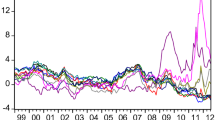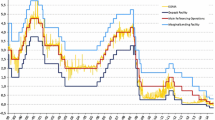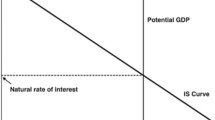Abstract
Estimating interest rate reaction functions for the euro area is still hampered by the short time span since the conduct of a single monetary policy. This is why estimates of union-wide reaction functions are usually based on historical pre-EMU data. In this paper we circumvent the common use of aggregated data before 1999 by estimating interest rate reaction functions based on a panel including actual EMU Member States. We find that exploiting the cross-section dimension of a multi-country panel and accounting for cross-country heterogeneity in advance of the single monetary policy improves the ability of historical reaction functions to describe actual interest rate dynamics. We retrieve a panel reaction function which is employed for evaluating interest rate setting since 1999.
Similar content being viewed by others
References
Adema Y (2004) A Taylor rule for the euro area based on quasi-real time data. DNB Staff Report No.114/2004, De Nederlandsche Bank
Bagliano FC, Favero CA (1998) Measuring monetary policy with VAR models: an evaluation. Euro Econ Rev 42:1069–1112
Baltagi BH, Griffin JM, Xiong W (2000) To pool or not to pool: homogeneous versus heterogeneous estimators applied to cigarette demand. Rev Econ Stat 82(1):117–126
Breitung J (2005) A parametric approach to the estimation of cointegration vectors in panel data. Econ Rev 24:151–173
Christensen AM, Nielsen HB (2003) Has US monetary policy followed the Taylor rule? A cointegration analysis 1988–2002. Working Paper 11/2003, Danmarks Nationalbank
Clarida R, Galí J, Gertler M (1998) Monetary policy rules in practice. Some international evidence. Euro Econ Rev 42:1033–1067
Clausen V, Hayo B (2005) Monetary policy in the euro area—lessons from the first years. Int Econ Econ Policy 1(4):349–364
Clausen JR, Meier C-P (2005) Did the Bundesbank follow a Taylor rule? An analysis based on real-time data. Swiss J Econ Stat 141(2):213–246
Coenen G, Vega J-L (2001) The demand for M3 in the euro area. J Appl Econ 16:727–748
Diebold FX, Mariano RS (1995) Comparing predictive accuracy. J Business Econ Stat 13(1):27–37
Fagan G, Henry J, Mestre R (2005) An area-wide model for the euro area. Econ Modelling 22(1): 39–59
Faust J, Rogers JH, Wright JH (2001) An empirical comparison of Bundesbank and ECB monetary policy rules. Int Financ Dis Paper No.705, Board of Governors
Favero CA, Rovelli R (1999) Modelling and identifying central banks’ preferences. CEPR Discussion Paper No.2178, Centre for Economic Policy Research, London
Gerdesmeier D, Roffia B (2004) Empirical estimates of reaction functions for the euro area. Swiss J Econ Stat 140(1):37–66
Gerlach-Kristen P (2003) Interest rate reaction functions and the Taylor rule in the euro area. Working Paper No.258, European Central Bank, Frankfurt
Gerlach S, Schnabel G (2000) The Taylor rule and interest rates in the EMU area. Econ Lett 67:165–171
Goodfriend M (1998) Using the term structure of interest rates for monetary policy. Federal Reserve Bank Richmond Econ Q 84(3):13–30
von Hagen J, Brückner M (2002) Monetary and fiscal policy in the European monetary union. IMES Discussion Paper No. 2002-E-16, Bank of Japan
Hayo B, Hofmann B (2003) Monetary policy reaction functions: ECB versus Bundesbank. Working Paper B24/2003 ZEI Bonn
Heinemann F, Hüfner FP (2004) Is the view from the eurotower purely European?. National divergence and ECB interest rate policy. Scott J Polit Econ 51:544–558
Im KS, Pesaran MH, Shin Y (2003) Testing for unit roots in heterogeneous panels. J Econ 115:53–74
Johansen S (1991) Estimation and hypothesis testing of cointegration vectors in Gaussian vector autoregressive models. Econometrica 59(6):1551–1580
Johnston J, DiNardo J (1997) Econometric methods. 4th edn, New York
Judd JP, Rudebusch GD (1998) Taylor’s rule and the Fed: 1970–1997. FRBSF Econ Rev 3:3–16
Judson RA, Owen AL (1999) Estimating dynamic panel data models: a guide for macroeconomists. Econ Lett 65:145–150
Kozicki Sh, Tinsley PA (2001) Shifting endpoints in the term structure of interest rates. J Monetary Econ 47:613–652
Larsson R, Lyhagen J, Löthgren M (2001) Likelihood-based cointegration tests in heterogeneous panels. Econ J 4:109–142
MacDonald R, Taylor MP (1994) The monetary model of the exchange rate: long-run relationships, short run dynamics and how to beat a random walk. J Int Money Financ 13:276–290
Mehra YP (2001) The bond rate and estimated monetary policy rules. J Econ Business 53:345–358
Mihov I (2001) Monetary policy implementation and transmission in the European monetary union. Econ Policy 16(33):371–406
Nautz D, Wolters J (1999) The response of long-term interest rates to news about monetary policy actions: empirical evidence for the US and Germany. Weltwirtschaftliches Archiv 135:397–412
Ng S, Perron P (2001) Lag length selection and the construction of unit root tests with good size and power. Econometrica 69(6):1519–1554
Österholm P (2005) The Taylor rule: a spurious regression?. Bull Econ Res 57(3):217–247
Pedroni P (2000) Fully modified OLS for heterogeneous cointegrated panels. In: Advances in econometrics, nonstationary panels, panel cointegration and dynamic panels vol 15. JAI Press, pp 93–130
Pedroni P (2001) Purchasing power parity tests in cointegrated panels. Rev Econ Stat 83:727–731
Peersman G, Smets F (1999) A Taylor rule: a useful monetary benchmark for the euro area?. Int Finance 2(1):85–116
Pesaran MH, Shin Y (1999) An autoregressive distributed lag modelling approach to cointegration analysis. In: Strom S (ed) Econometrics and economic theory in the 20th Century: the Ragnar Frisch centennial symposium. Cambridge University Press, Cambridge
Pesaran MH, Smith R (1995) Estimating long-run relationships from dynamic heterogeneous panels. J Econ 68:70–113
Pesaran MH, Shin Y, Smith RP (1999) Pooled mean group estimation of dynamic heterogeneous panels. J Am Stat Assoc 7(2):127–146
Sauer S, Sturm J-E (2003) Using Taylor rules to understand ECB monetary policy. CESifo Working Paper No.1110 Munich
Siklos PL, Wohar ME (2004) Estimating Taylor-type rules: an unbalanced regression? Paper presented at the 3rd Annual ‘Advances in Econometrics’ conference, Louisiana State University
Smant DJC (2002) Has the European Central Bank followed a Bundesbank policy? Evidence from the early years. Kredit und Kapital 35(3):327–343
Surico P (2003) Asymmetric reaction functions for the euro area. Oxford Rev Econ Policy 35(3):327–343
Taylor JB (1993) Discretion versus policy rules in practice. Carnegie-Rochester conference series on public policy 39:195–214
Taylor JB (1999) The robustness and efficiency of monetary policy rules as guidelines for interest rate setting by the European Central Bank. J Monetary Econ 43:655–679
Ullrich K (2003) Comparison between the Fed and the ECB: Taylor rules. Discussion Paper No.03-19, ZEW Mannheim
Wesche K (2003) Monetary policy in Europe: evidence from time-varying Taylor rules. Bonn Econ Discussion Paper No. 21/2003, University of Bonn
Wyplosz Ch (1999) Economic policy coordination in EMU: strategies and institutions. CEPII Document de Travail No.99-04, presented at the fourth Franco-German forum on economic policy coordination, 11/12 January 1999, Bonn
Zellner A (1962) An efficient method of estimating seemingly unrelated regressions and test for aggregation bias. J Am Stat Assoc 57:348–368
Author information
Authors and Affiliations
Corresponding author
Rights and permissions
About this article
Cite this article
Ruth, K. Interest rate reaction functions for the euro area. Empirical Economics 33, 541–569 (2007). https://doi.org/10.1007/s00181-006-0117-y
Received:
Accepted:
Published:
Issue Date:
DOI: https://doi.org/10.1007/s00181-006-0117-y




